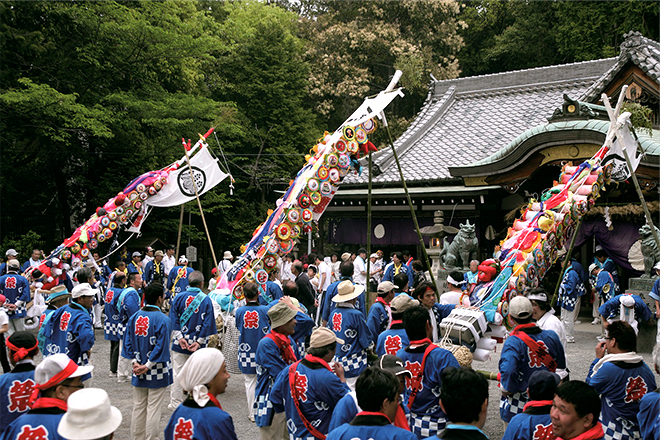Pillow Festival of Hine Jinja Shrine
The spring festival mentioned in the diary of Kujo Masamoto, the lord of Hinenosho, is believed to be the origin of this festival. Masamoto wrote that he was impressed by the performing arts and other events held there.

This spring festival is held at Hine Jinja Shrine in the Hineno area on May 4 and 5 every year. The peculiar event is called the “Makura Matsuri” (Pillow Festival) because it involves a parade of three flags along with gorgeous decorative pillows. While the festival used to be organized jointly by the three districts of Hineno, Kaminogo and Nagataki, a rotation system in which the districts take turns being in charge of the event was introduced in 1926. The decorative pillows used exclusively for the festival are produced mainly by women in the hope of good matches, easy delivery of babies and an abundant harvest. There are not many spring festivals in the neighborhood, and festivals with a parade of decorative pillows are rare in the country.
Parades to Mt. Funaoka were suspended in 1958, and the parade currently travels to and from otabisho (a place where the sacred palanquin is lodged during a festival) in Nagataki.
The parishioners in the three districts, Hineno, Kaminogo and Nagataki, take turns being responsible for the festival. A procession carrying a flag with the shrine name, an osakaki (sacred tree), saltwater, a hire (scarf) flag, swords, bows and arrows, Sarutahiko (a Shinto god), drums, a sacred palanquin and first, second and third flags parades around the towns. Participants carry the flags along with colorful decorative pillows attached to 5-meter bamboo poles and parade to otabisho in Nagataki while singing Gosha Ondo. The Pillow Festival was once known as a fighting festival as well, and the stone stairway down from the tower gate of the shrine grounds was the first place to fight.
While stone lanterns still stand at street corners in the towns of Hineno, a toroza (a kind of religious group) was organized in the past, and children in the towns lit up lanterns made of hexagonal paper and offered them to Hine Jinja Shrine every evening for a month before the festival. The parade involves a cry of “seroja, maroja,” which is a corrupted form of the words “sentoro ja, mantoro ja” (thousand lanterns, ten thousand lanterns). Although it is now the rule that 25 decorative pillows should be attached per flag, a maximum of 50 to 60 pillows were attached previously, and it is said that the flags were so heavy that the poles broke many times in the course of the parade.
The current Pillow Festival is contrastingly gentle in comparison with the previous boisterous style. After oharai (purification) of the flags along with the pillows, the parade returns slowly while stopping at spots to enjoy alcohol and food, which is a familiar sight for local people in spring.






